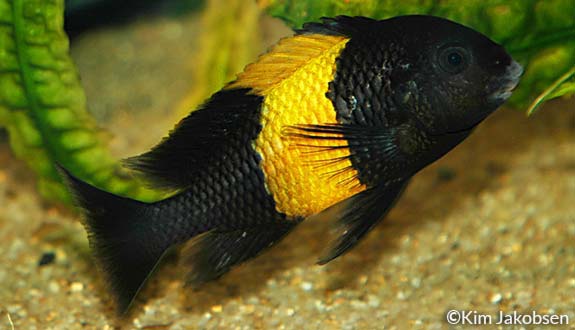

Alternative species (click on the thumbnail to see the card)
Names
Scientific name
Tropheus sp. Black
Common name
see “to know”
Origin

Origin: North of the Lake Tanganyika
Biotope: African
Dimorphism

Quite difficult. Generally, males are slightly larger than females (but this is not always true). Females are a little duller
Group

Cichlidae
Volume

350 L / 77 imp gal / 92 US gal
Parameters

T°: 25 à 26°C or 77 to 79°F
pH: greater than 8
Hardness: 8 to 22°dGH
Difficulty

Average
Size

10 to 12 cm (4 to 5")
Longevity

10 to 12 years
Living zone

Everywhere
Individuals

Harem (1 male for 5/6 females)
Food
How to feed the Tropheus?
Food
How to feed the Tropheus?
Tropheus are very sensitive to their diet and easily develop intestinal infections. Any change of diet, unadapted diet, overeating or stress can cause this type of affection. Your fish will then be swollen, as if bloated. Follow the tips below to limit the risks.
This fish is omnivorous with a strong herbivorous tendency. In nature, it is mostly a grazer of seaweed. In the aquarium, offer it flakes or granules of high quality and high content of spirulina and fiber as the basis of its diet. You will let these foods moisten in the water a few minutes before distribution.
Fill with fresh vegetables such as spinach or salad for example (cut into small pieces if they do not touch the whole leaf) at least once a day.
Avoid as much as possible high-protein meat foods such as Tubifex, Artemia, Mosquito larvae and Ox heart. These foods are dangerous for the Tropheus. Prefer cyclops, to give twice a week.
To avoid deficiencies, you can add vitamins to their diet.
Finally, distribute small meals, but frequently (at least 3 times a day). Be careful because they are voracious and always seem to be hungry. However, overeating can cause serious health problems with this sensitive fish!
Behavior
What kind of behavior does the Tropheus have?
Behavior
What kind of behavior does the Tropheusa have?
They are very active, spending their time swimming or trying to graze algae. They are also curious and they like to play arround, their behavior is very attractive. Some aquarists will even tell you that they stand out by their intelligence. The infraspecific interactions are exciting and a very stable hierarchy is established quickly.
The group must be introduced in its entirety from the beginning, preferably with young specimens (no more than 3 cm or 1.2 inch). Indeed, the addition of a new fish to an already formed group is very risky, leading in most cases to the death of the new fish. If you have no choice but to add new individuals, introduce the new fish at night after the lights go out. Also change the layout of the decor completely, even the stones. The territories will be disrupted and the chances of integration will be higher. Be careful, however, the integration of a new individual is never guaranteed, even doing so. You will also notice that it is a stressful episode for the whole group, and who says stress for the Tropheus, says risk of disease! So be very very careful and well prepared for this tricky maneuver.
Cohabitation
Who can live with the Tropheus?
Cohabitation
Who can live with the Tropheus?
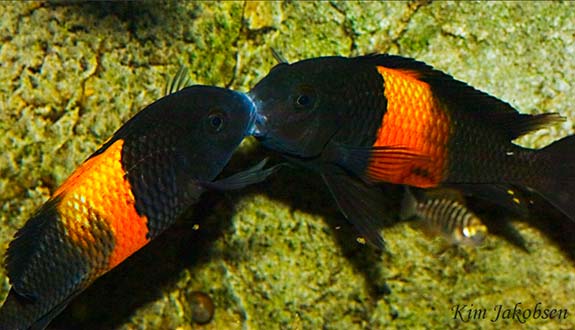
Two males fighting
This species enjoys living in a group, and more specifically in harem. A group will therefore always consist of one male for five to six females. This proportion dilutes the aggressiveness of the male on several females. The social ideal is to maintain 12 individuals (or even 15) in the same aquarium. This represents two aggressive males to each other. This is why you should consider this ideal only in aquariums of at least 500 liters or 110 Imp Gal or 132 US Gal, with distinct territories. Below this volume, it is better to avoid male cohabitation and install only one group of 6 or 7 individuals.
In general, the Tropheus is quite aggressive. It is territorial and does not support intrusion into its territory. Conflicts with other territorial species are inevitable, and fighting will be violent. Avoid at all costs this kind of association. On the other hand, it is a little more tolerant towards non-territorial species. The fish too quiet will be disturbed by the intense activity of the Tropheus.
An unusual cohabitation restriction is added: the delicate diet of the Tropheus. Indeed, if it is maintained with fish requiring a lot of meat food, it will inevitably consume them too. This will cause health problems for the Tropheus, which can sometimes be fatal.
For all these reasons, we recommend a specific aquarium for your Tropheus!
Breeding
How to breed the Tropheus?
Breeding
How to breed the Tropheus?
Breeding is feasible. The male is always disposed, unlike females who may be longer to put in “breeding” mode. Sexual maturity is reached when specimens are between 5 and 6 cm or 2 and 2.4 inch.
Tropheus in good health and who enjoy themselves in their aquarium can lay once a month. Each egg-laying consists of between 10 and 20 yellowish eggs. Since this fish is an oral incubator, the female will collect its eggs in its mouth where they will be safe for 4 to 6 weeks. During this period, the female stops feeding. You should not worry, it's a normal behavior. The female must nevertheless resume feeding itself after the expulsion of the fry. The fry are quite big (more than 1 cm or 0.4 inch). There is no predation from the parents so they can stay togheter.
If your fish are in a community aquarium, you can remove the fry to raise them in a separate aquarium to protect them from other fishes’ appetites. In addition, some Tropheus strongly protect their young which can cause conflict where everything is quiet outside breeding periods.
Fry food: cyclops, crushed flakes.
Note that the first layings of young mothers are often lost during the process.
Its aquarium
Which aquarium for the Tropheus?
Its aquarium
Which aquarium for the Tropheus?
In its natural environment, the Tropheus lives in the midst of rocky scree. Reproduce these conditions in your aquarium with large rocks. It will be necessary to provide equivalent territories in different places, or just a linear decoration at the bottom of the aquarium. This will lower the aggressiveness of the species. Attention to the stability of your arrangement (do not hesitate to stick the stones between them).
Do not skimp on the lighting: the more powerful it is and the more the seaweed will form: a treat for your boarders! Moreover, if you have rocks covered with seaweed, do not hesitate to put them in their aquarium: a true happiness for them!
As it is herbivorous, choose resistant plants like Anubias if you want some plants in your aquarium.
For the quality of the water, a brief reminder of the natural conditions is necessary. Lake Tanganyika is deep and its water is very stable. The water is also very oxygenated. To reproduce these conditions in captivity, opt for a powerful filtration capable of maintaining a good quality of water and a good rate of oxygenation. This species is quite sensitive to the pollution of its water. You must also make water changes regularly. Leave on 15% of the total volume twice a week preferably, or 30% every two weeks. Make sure that the new water has the same chemical parameters and the same temperature as the main aquarium. Indeed, the Tropheus do not support the variations of parameters.
For the soil, choose imperatively fine gravel or sand. Indeed, after the meal, the Tropheus is used to continue looking for its food by digging in the sand. It takes a bite and spits it out. They swallow a little of this sand each time, which seems to be beneficial for their digestive system.
Good To know
Find all additional information!
Good To know
Find all additional information!
They are quite sensitive and should only be maintained by aquarists who already have experience with Lake Tanganyika fishes. In fact, they easily develop intestinal infections if their diet does not correspond perfectly to their needs, if the quality of the water is insufficient or if they are stressed.
Tropheus have the ability to vary their color according to their mood. For example, during the breeding season, they will force on their colors which will then be even more contrasted than in normal times. A real delight!
It seems that the Tropheus emit sounds allowing them to communicate (with 6 different types of tones against 2 usually for other fish).
There are 6 species of Tropheus described scientifically:
Tropheus Moorii – 50 varieties of colors
Tropheus Brichardi
Tropheus Duboisi
Tropheus Annectens
Tropheus Kasabae
Tropheus Polli (A debate is currently underway to find out if it ranks in the same category because of its caudal fin).
This sheet dedicated to the Tropheus sp Black includes a number of varieties that are not recognized as separate species and not associated with those previously mentioned. Indeed, this name actually includes several species. Even if all these species originate from Lake Tanganyika, each one is differentiated by its geographical area, sometimes a very small rocky area. Their common point is a dark general dress, traversed by a more or less wide lateral band. This band can be yellow or red. In order to maintain the purity of its strains, make sure not to combine different species of Tropheus Black from different geographical areas in the same aquarium. Here is the list of species of Tropheus sp. Black:
Caramba
Rutunga
Banza
Kirchfleck
Mboko
Kifumbwe
Minago
Uvira
Bulu Point
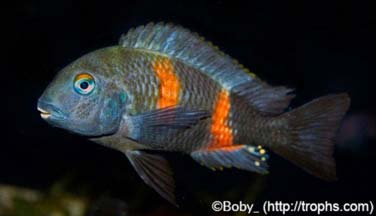
Ikola
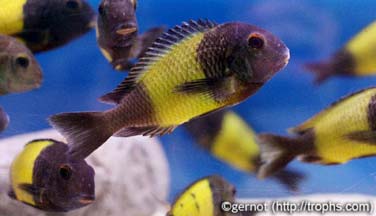
Kiriza
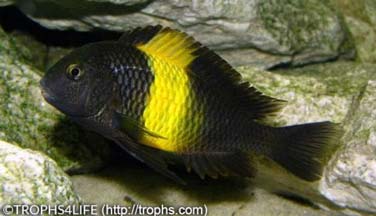
Kiriza gold
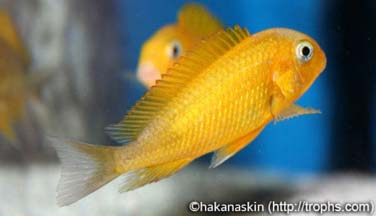
Lueba
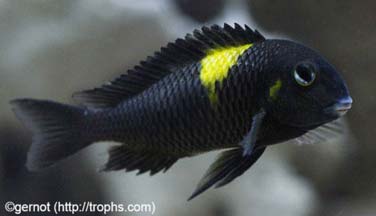
Makobola
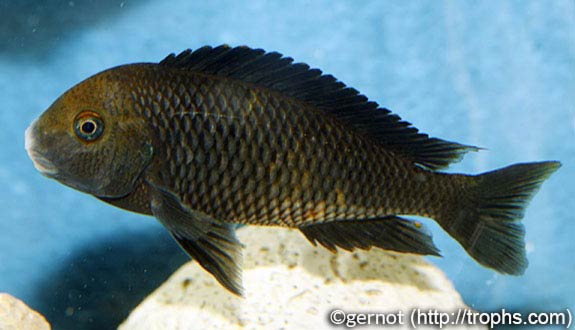
Pemba (Bemba)
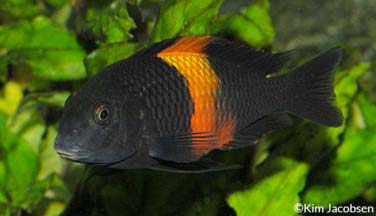
Muzimu
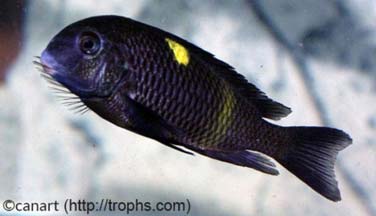
Magara
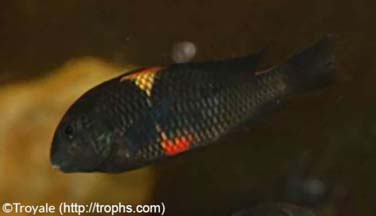
Yours photos!

By Encyclo-Caro

By Encyclo-Caro

By Encyclo-Caro

By Encyclo-Caro

By Encyclo-Caro
Comments
Sort by:
Please login to post comments
